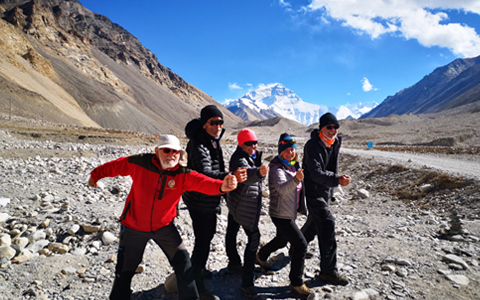Mount Kailash is unique among mountains being both unclimbed and unclimbable, but for reasons that might surprise you. At 6,638 meters it is far from being one of the highest peaks in Tibet, but it still hasn’t been climbed in modern times. The mountain's challenging shape, harsh weather, and remote location make it difficult, and its cultural significance stops people from even thinking about attempting it. Why has Mount Kailash not been climbed? Keep reading to find out.
Climbing Mount Kailash is not Allowed in Four Religions
Mount Kailash is sacred to four religions. Followers of Hinduism, Buddhism, Jainism and the Bon religion all revere the mountain as the abode of the gods and a place of spiritual enlightenment.
 Mount Kailash is a sacred mountain of the Hinduism, Buddhism, Jainism and the Bon.
Mount Kailash is a sacred mountain of the Hinduism, Buddhism, Jainism and the Bon.Mount Kailash is known as Mount Meru in Buddhist texts. A place at the center of Buddhist cosmology, and an important pilgrimage site. Pilgrims travel long distances to pray along the sacred route around the mountain’s base.
In Hinduism, Mount Kailash is the abode of Lord Shiva and his consort, the goddess Parvati. For Hindus, the Kailash Manasarovar Yatra around the mountain is a pilgrimage of a lifetime. Attempting to summit Mount Kailash is deeply disrespectful to these beliefs.
Jain scriptures hold that Mount Kailash is where their founder, Rishabhantha, achieved enlightenment. The mountain is considered the center of the entire universe.
Mount Kailash is known as the ‘axis mundi’ in the Bon religion. The place that connects heaven and earth, facilitating the connection between deities and people with prayers ascending to heaven and blessing descending to Earth.
The cultural prohibitions against climbing the mountain due to its spiritual importance run very deep for followers of these religions. Keeping the mountain free of climbers preserves its spiritual essence and fragile ecosystem.
Climbing Mount Kailash is Difficult due to Its Pyramid-like Appearance
Mount Kailash is known for its four sheer faces that create its iconic, pyramid-like appearance. Its height, at 6,638 meters, is already a daunting challenge, but combined with the steep, symmetrical inclines and icy ridges, it is all the more formidable.
The high elevation is a low oxygen environment that would place climbers at serious risk of altitude sickness. Additionally, its unique shape would mean having to overcome sharp and exposed rock formations, as well as some almost vertical slopes. The multi-faceted combination of physical challenges would be impossible for any but the most experienced climbers, and then only with help from the most modern equipment.
 Climbing Mount Kailash is difficult owing to its pyramid-like appearance.
Climbing Mount Kailash is difficult owing to its pyramid-like appearance.Climbing Mount Kailash will Face Harsh Weather and a Remote Location
Sitting in the distant Ngari Prefecture in western Tibet, Mount Kailash is extremely remote. The surrounding terrain is rugged and difficult to navigate. It is also far away from modern infrastructure. Nearby settlements are small, without the resources needed to climb the mountain. The logistical challenges of executing a climb of Mount Kailash have kept many from trying.
The region is also known for its extreme weather which is often unpredictable and harsh. Climbing Mount Kailash would mean facing sub-zero temperatures, high winds, and the possibility of sudden snowstorms. These conditions create a significant chance of frostbite and hypothermia, with rescue and treatment options far away. Combined with the reduced oxygen levels, anyone trying to climb the mountain would be facing serious risks.
Has Anyone Climbed Mount Kailash before? Who has climbed Mount Kailash?
A Buddhist legend holds that Milarepa, the champion of Vajrayana Buddhism challenged the champion of the Bon religion, Naro Bon-Chung, to climb the mountain. Milarepa won by ascending the mountain on a ray of sunlight, and claimed Mount Kailash for Buddhism.
Since that time, there have been no recorded successful climbers of the mountain. In 1926, Hugh Ruttledge, a famous English mountaineer, studied the north face and declared it “utterly unclimbable”. Colonel R. C. Wilson who was exploring the southern face at the same time claimed to have identified a route to the peak, but then was prevented from climbing by heavy snows.
 All attempts to climb the Mount Kailash have failed.
All attempts to climb the Mount Kailash have failed.The famous Australian author and climber Herbert Tichy explored the region in 1936. He tells of asking a local lama whether Mount Kailash could be climbed. The lama replied “Only a man entirely free of sin could climb Kailash. And he wouldn't have to actually scale the sheer walls of ice to do it – he'd just turn himself into a bird and fly to the summit.”
It was not until the 1980s that someone was given formal permission to climb the mountain. Reinhold Messner, the first person to climb Mount Everest solo, and the first to climb it without supplemental oxygen was given the opportunity but refused saying "If we conquer this mountain, then we conquer something in people's souls."
In 2001, controversial stories of a Spanish team planning to climb the peak emerged. This led to the Chinese government formally prohibiting anyone from trying to summit the sacred mountain.
Taking the Mount Kailash Kora Trek is More Meaningful and Realizable
Mount Kailash Kora, a circumambulation around the sacred mountain, is a more meaningful way to experience a visit there. A kora is a way for pilgrims to honor and take part in the religious traditions of Mount Kailash while experiencing its stunning natural beauty. It is believed that taking part in the tradition purifies the soul and is a way to accumulate merit.
 Pilgrims do kora around the holy Mount Kailash.
Pilgrims do kora around the holy Mount Kailash.It is also something that you can actually do. The kora is an accepted and respected way to engage with the spiritual essence of the region. It also honors the religious prohibitions against climbing the mountain.
Doing a kora usually takes three days. Starting from Darchen, you’ll be bused to Sarshung Valley where the first day of trekking begins. It is a relatively easy 13 km trek through the valley with a clear view of the southern and western slopes of Mount Kailash. At the foot of the western slope, you’ll arrive at Dirapuk Monastery to explore the ancient site and spend the night.
Day 2 is the most challenging day of trekking. You’ll reach the highest point of the kora at Dolma La Pass (5,630 meters) after a rapid ascent up the mountain. Even in summer, glaciers can be seen as well as the emerald-green Lake of Compassion. The trekking ends with a gradual descent to Zutulpuk Monastery and spend the night there.
On day three you’ll complete the kora with a trek from Zutulpuk Monastery back to Darchen. After day 2, the 12 km trek won’t feel difficult. You’ll arrive back in Darchen early enough to be able to visit the holy Lake Mansarovar. There is even a hot spring available, for people who choose to take part.
Conclusion
Religious beliefs surrounding Mount Kailash not only make it unclimbable but also ensure it will stay that way. The harsh climate and sheer rock faces may deter aspiring climbers, but the deep spiritual significance of the region attracts thousands of visitors and pilgrims every year. With the prohibitions against climbing in place, you can be sure that when you decide to visit, you’ll find the same pristine environment that first attracted people’s spiritual devotion.
The 3-day kora trek is the best way to visit Mount Kailash and get close enough to feel its powerful energy. With our decades of experience in bringing tourists and pilgrims to the region, we will make sure to make your Mount Kailash tour a successful and meaningful one.

























 Mount Kailash is a sacred mountain of the Hinduism, Buddhism, Jainism and the Bon.
Mount Kailash is a sacred mountain of the Hinduism, Buddhism, Jainism and the Bon.
 Climbing Mount Kailash is difficult owing to its pyramid-like appearance.
Climbing Mount Kailash is difficult owing to its pyramid-like appearance. All attempts to climb the Mount Kailash have failed.
All attempts to climb the Mount Kailash have failed. Pilgrims do kora around the holy Mount Kailash.
Pilgrims do kora around the holy Mount Kailash.
















Ask a Quick Question